Learning how to clean an electric kettle can be a real lifesaver! This handy little kitchen appliance is very common in households thanks to its convenience and quick boiling functionality, especially when compared to a stovetop kettle.

But it's important to learn how to clean your electric kettle too! This is because hard water built up inside the kettle can affect how well it functions and even affect your little appliance's life span.
Each time you use the kettle with hard water, small amounts of minerals are left behind. Over time, these minerals form deposits commonly known as hard water build-up or scale. This build-up can affect the performance, efficiency, and lifespan of your electric kettle
So, in this article, I'll teach you exactly how to remove hard water build-up and clean an electric kettle. Read on to learn exactly how!
Table of Contents
Why Clean an Electric Kettle?
Hard water is a common issue in many households but its impact often goes unnoticed until it's too late. Its hardness is attributed to high mineral content, particularly calcium and magnesium.
These minerals are healthy for human consumption, but they can wreak havoc on many household appliances, including your electric kettle.
Minerals Deposit at the Bottom of the Kettle
When hard water is heated in an electric kettle, the minerals present in the water start to separate and settle at the bottom of the kettle. This process is known as precipitation.
The higher the mineral content in the water, the more pronounced the precipitation becomes. As the water boils, the heat causes the minerals to crystallize and form deposits on the heating element and the interior surfaces of the kettle.
Negative Impact on Electric Kettle
These deposits, commonly known as hard water build-up or scale, can have a negative impact on the performance, efficiency, and lifespan of your electric kettle.
The build-up acts as an insulator, reducing the efficiency of the heating element and making it take longer for the water to boil. This not only wastes energy but also increases your electricity bills.
Additionally, the scale can affect the taste and quality of the water, leaving a chalky residue that alters the flavor of your tea or coffee.
Deteriorates Interior Surface of Kettle
Moreover, the hard water build-up can lead to the deterioration of the kettle's interior surfaces. The minerals can corrode the metal or plastic parts, causing discoloration, rust, or even leaks.
This not only compromises the functionality of the kettle but also poses a potential health risk if the degraded parts come into contact with the water you consume.
Identifying Hard Water Build-Up in Your Kettle
Signs of Hard Water Build-Up
Hard water leaves behind a tell-tale sign inside your kettle: a white or brownish layer on the bottom and sides of the kettle.
This build-up is caused by the presence of minerals, such as calcium and magnesium, which are commonly found in hard water.
As the water evaporates during boiling, these minerals are left behind, forming a stubborn residue that clings to the kettle's surfaces.
In addition to the visible build-up, there are other signs that can indicate the presence of hard water deposits in your kettle. You may notice slower boiling times, as the mineral deposits act as an insulator and reduce the efficiency of the heating element.
This can be frustrating, especially when you're in a hurry to make your morning cup of tea or coffee.
Potential Risks of Ignoring Hard Water Build-Up
While hard water isn't harmful to ingest, it can negatively affect your kettle’s performance. Ignoring the build-up can lead to various issues that can impact your daily routine and even pose risks to your safety.
One of the main problems caused by hard water build-up is longer boiling times. As the mineral deposits accumulate on the heating element, they form an insulating layer that reduces the transfer of heat. This means that it takes longer for the water to reach boiling point, resulting in increased waiting times for your hot beverages.
Another consequence of ignoring hard water build-up is increased energy usage. The longer boiling times not only waste your time but also require more electricity or gas to heat the water. This can lead to higher energy bills, which can be avoided by regularly descaling your kettle.
Furthermore, if the build-up is left untreated for an extended period, it can cause malfunctions in your kettle. The mineral deposits can clog the small openings or valves, affecting the flow of water and steam. This can result in uneven heating or even complete failure of the kettle.
Perhaps the most alarming risk of ignoring hard water build-up is the potential fire hazard it poses. As the mineral deposits accumulate on the heating element, they can become too encrusted, leading to overheating.
This can cause the heating element to malfunction and potentially start a fire. Regular maintenance and descaling of your kettle are essential to prevent such dangerous situations.
Materials Needed for Cleaning Hard Water Build-Up
When it comes to cleaning hard water build-up from your electric kettle, you have several options. Let's explore some of the materials you can use to effectively remove those stubborn mineral deposits.
Household Items You Can Use
The good news is that cleaning hard water build-up from your electric kettle doesn't require specialized equipment. You can find most of the necessary materials right in your own home.
- Vinegar: One common household item that works wonders in removing hard water stains is white vinegar. Its acidic properties help dissolve the mineral deposits, making it easier to clean.
- Water: We'll dilute the vinegar with some water to create the ideal mixture to use to clean our electric kettle.
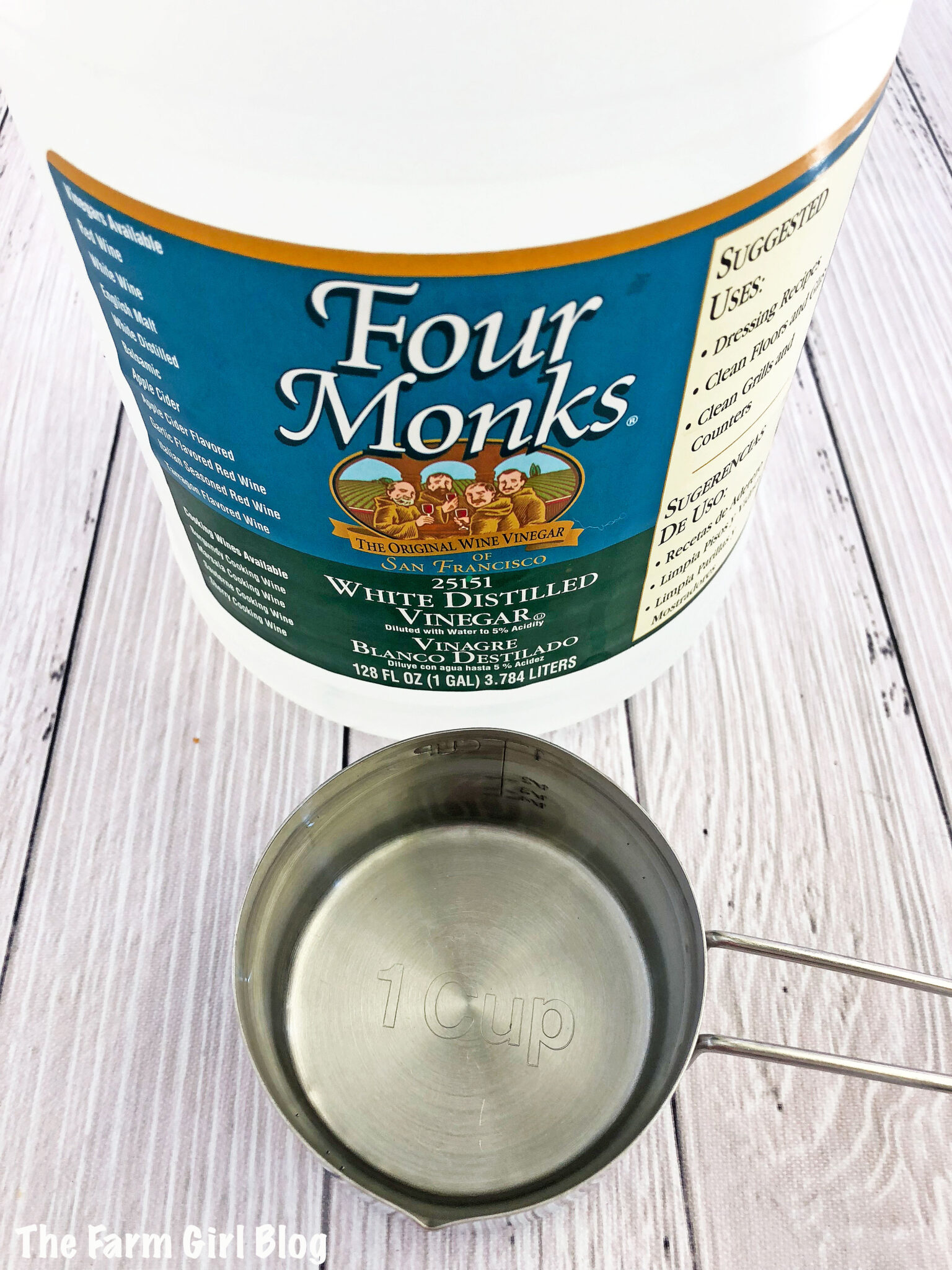
Other Supplies You'll Need
Apart from vinegar and water, here are the other basic household cleaning supplies you'll need to clean an electric kettle:
- Non-scratch sponge: We'll use this to gently scrub off the hard water deposits in our kettle.
- Dish soap: You'll also need some dish soap to clean the kettle properly inside and out.
- Electric kettle: And, of course, we'll need the electric kettle we'll be cleaning step by step!
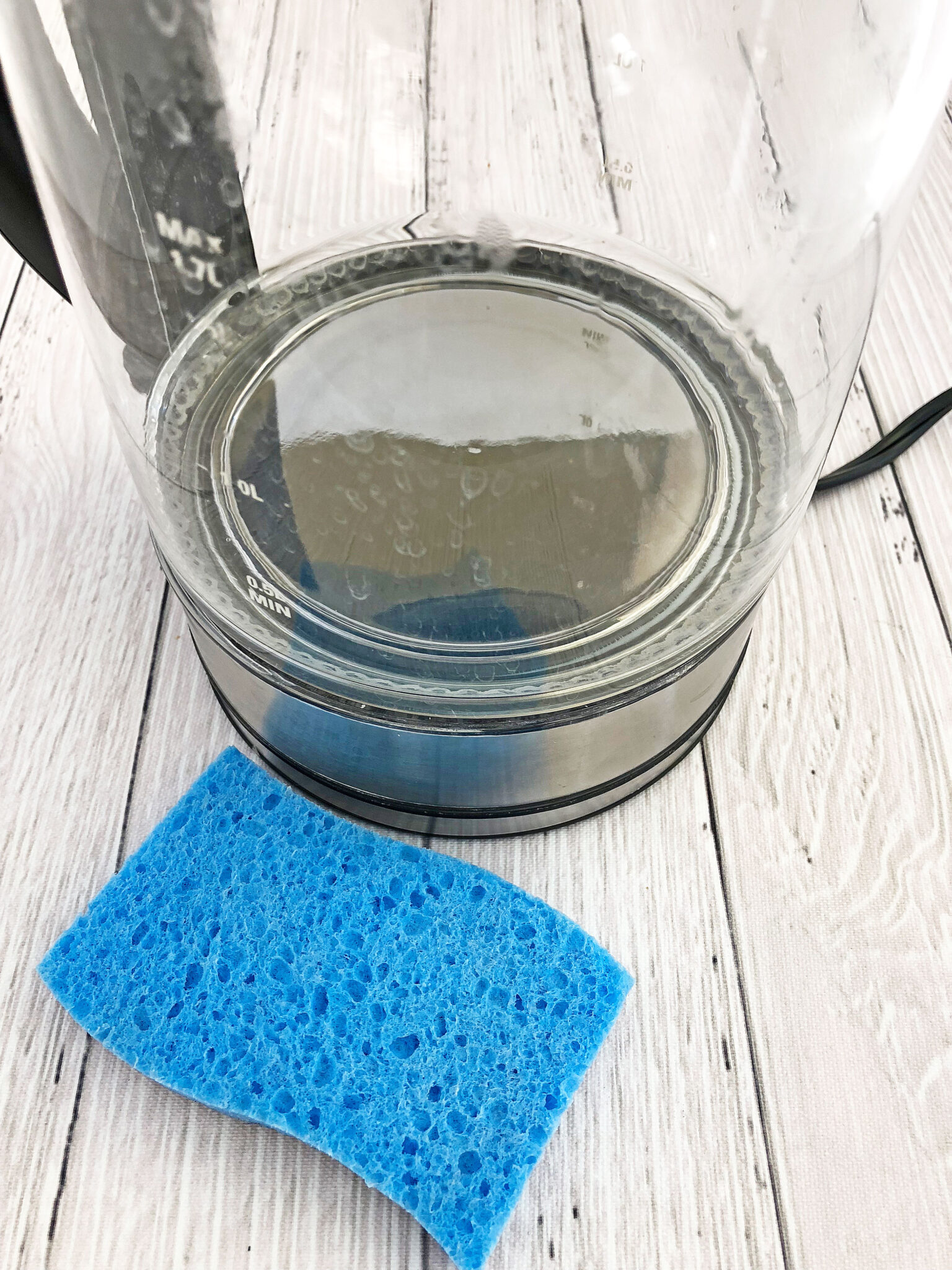
How to Clean an Electric Kettle (Step by Step)
Cleaning an electric kettle is easier than you think! Here's how to do it step by step to remove hard water build up inside your kettle:
Pour an equal amount of water and vinegar into a kettle. Boil the solution in a kettle couple for a couple of cycles (my kettle turns off automatically, so I run 2 boiling cycles).
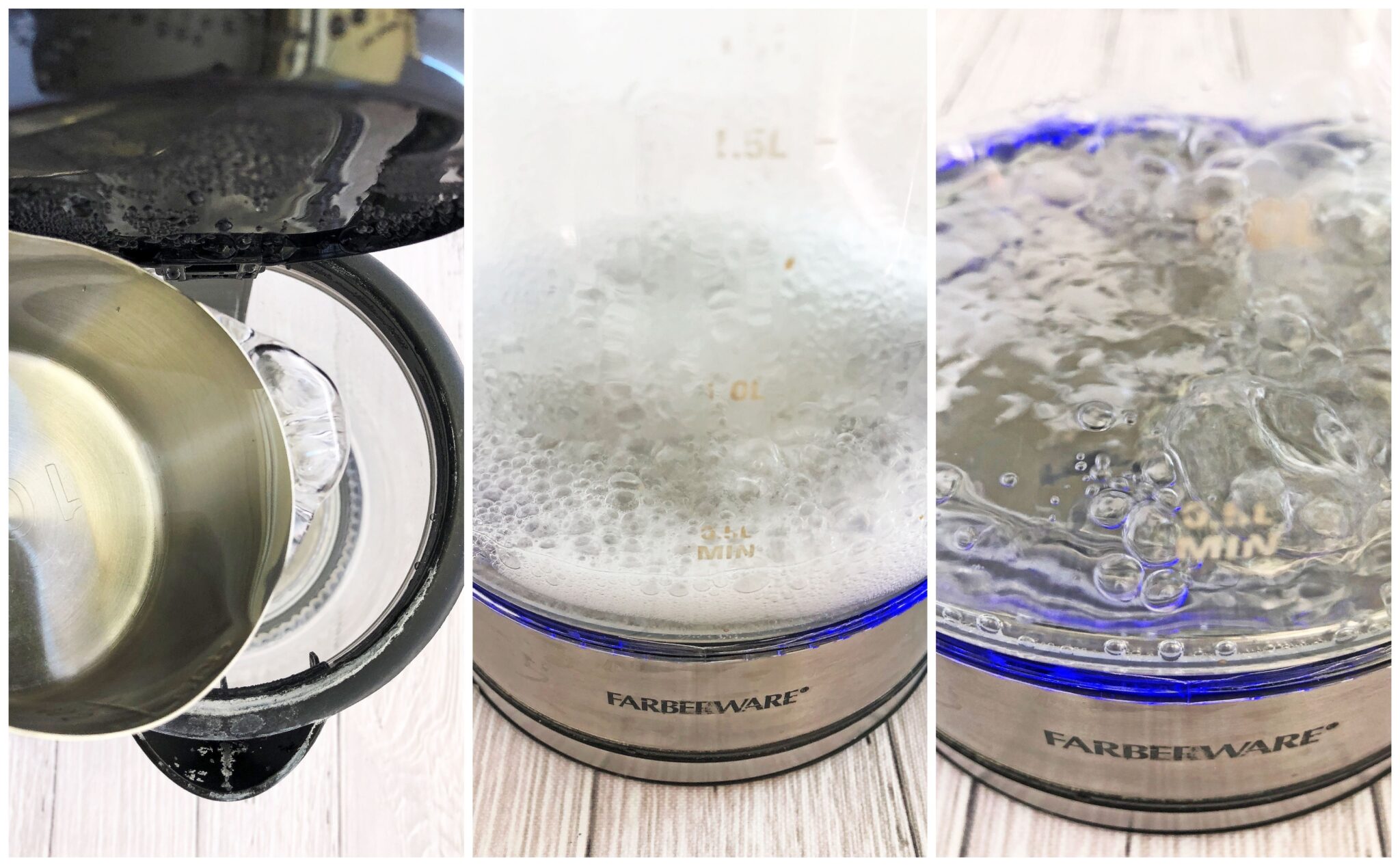
Let the vinegar solution cool to a warm temperature before pouring it out of the kettle. Unplug the power from a kettle, and pour the solution out of the kettle.
Using a soapy sponge, lather a kettle and rinse well under running water and allow it to dry completely before use.

After the kettle dries out, boil water in the kettle once again to remove the remaining traces of the vinegar.
Dump the water, and then the kettle is good to be used again.

And that's how you clean an electric kettle!

Having a clean and well-maintained electric kettle is essential for ensuring the longevity and optimal performance of this handy kitchen appliance.
And now you know exactly how to clean an electric kettle! Let me know in the comments below if you want me to write other guides like this one.
Here are the before pictures

Here are after pictures
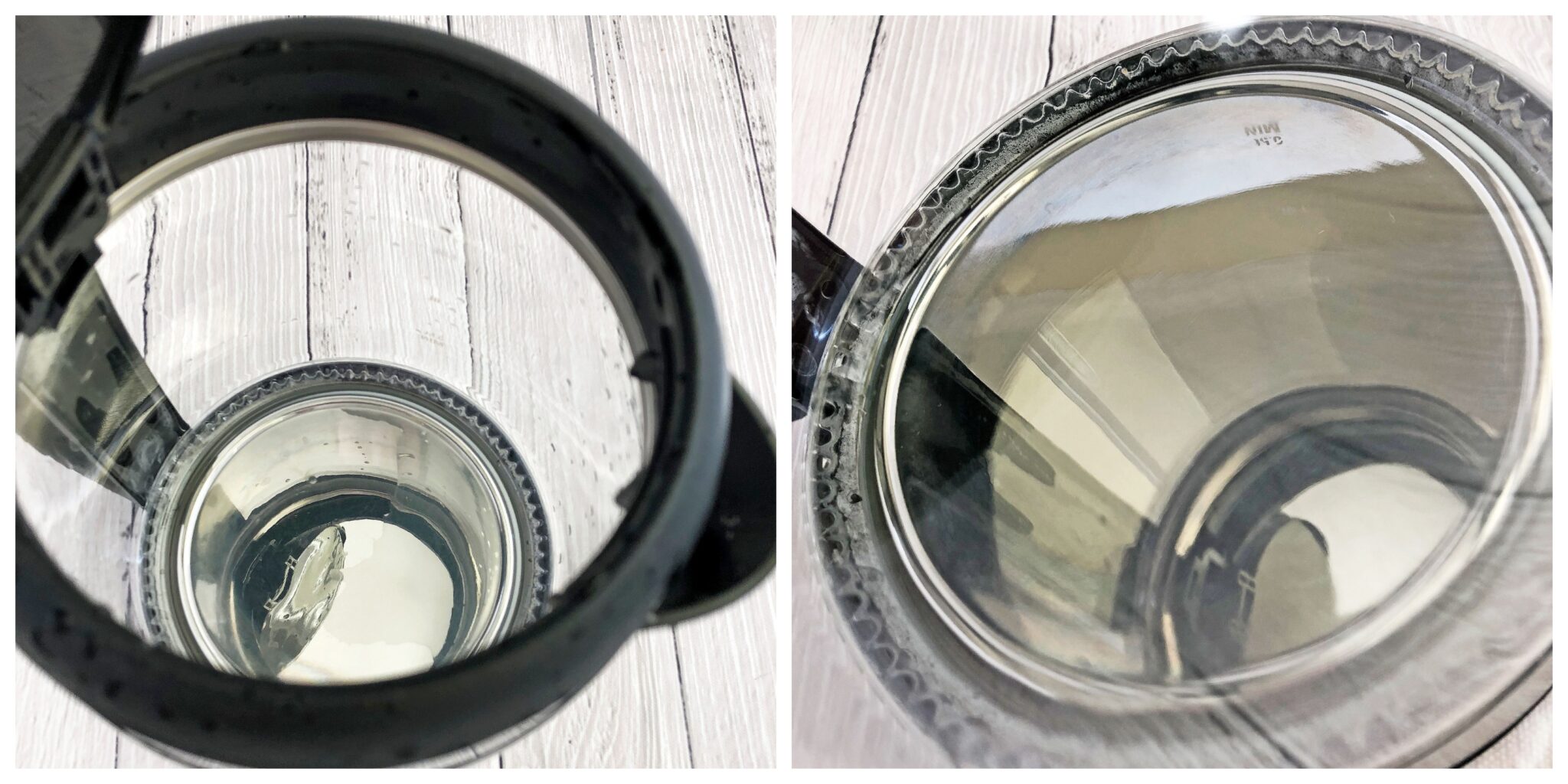
Related post:
How to Clean Stainless Steep Instant Pot Inner Pot
Printable Card

How to Clean an Electric Kettle and Remove Hard Water Built
Ingredients
Supplies to Remove Hard Water Build-Up and Clean an Electric Kettle
- Distilled Vinegar
- 1 cup – water
- Non-scratch sponge
- Dish soap
- Electric kettle
Instructions
How to Clean an Electric Kettle
- Pour an equal amount of water and vinegar into a kettle. Boil the solution in a kettle couple for a couple of cycles (my kettle turns off automatically, so I run 2 boiling cycles).
- Let the vinegar solution cool to a warm temperature before pouring it out of the kettle. Unplug the power from a kettle and pour the solution out of the kettle.
- Using a soapy sponge, lather a kettle and rinse well under running water and allow it to dry completely before use.
- After the kettle dries out, boil water in the kettle once again to remove the remaining traces of the vinegar.
- Dump the water, and then the kettle is good to be used again.
- And that's how you clean an electric kettle!
Thank you for following me on Facebook, Instagram, and Pinterest!


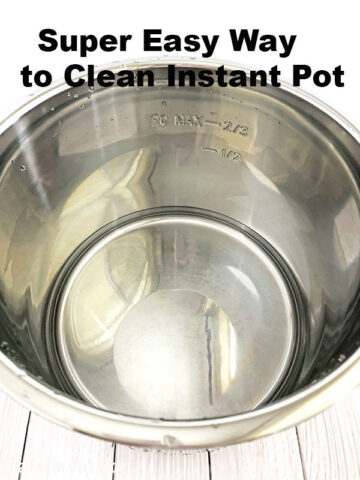
Thanks admin for sharing this informative post.
You are so very welcome!
I have apple cider vinegar at the moment, can i use that?
I've never tried using apple cider vinegar. Let me know how it goes if you ever try.
Electric kettle cleaning seemed to be a hard job. After reading these handy tips I believe these are the best ways to do this job.
I'm glad you found it helpful. Thank you for your comment!
Exactly what I needed, thanks for sharing!
You are most certainly welcome! I'm glad you found it helpful!
That worked fabulously on my electric stainless steel
Kettle !!
I'm so happy to hear that. Thank you for sharing your experience.